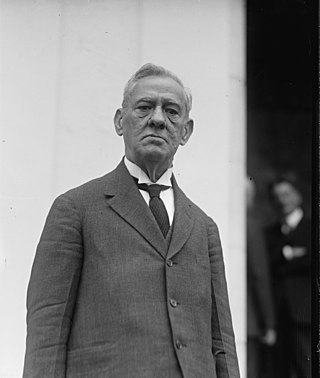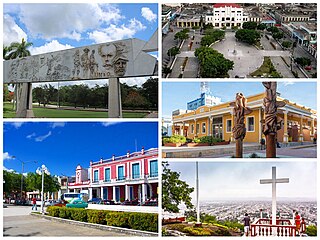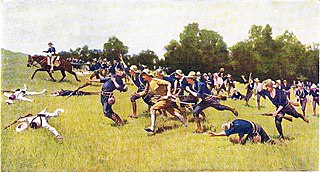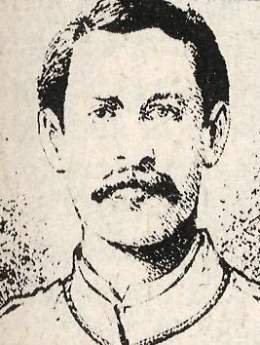
Alfredo de Zayas y Alfonso, usually known as Alfredo de Zayas under Spanish naming customs and also known as Alfredo Zayas, was a Cuban lawyer, poet and political figure. He served as prosecutor, judge, mayor of Havana, secretary of the Constitutional Convention, senator in 1905, president of the Senate in 1906, Vice President of Cuba from 1909 to 1913 and President of Cuba from May 20, 1921, to May 20, 1925.

Oriente was the easternmost province of Cuba until 1976. The term "Oriente" is still used to refer to the eastern part of the country, which currently is divided into five different provinces.

The Ten Years' War, also known as the Great War and the War of '68, was part of Cuba's fight for independence from Spain. The uprising was led by Cuban-born planters and other wealthy natives. On 10 October 1868, sugar mill owner Carlos Manuel de Céspedes and his followers proclaimed independence, beginning the conflict. This was the first of three liberation wars that Cuba fought against Spain, the other two being the Little War (1879–1880) and the Cuban War of Independence (1895–1898). The final three months of the last conflict escalated with United States involvement, leading to the Spanish–American War.

Calixto García Íñiguez was a Cuban general in three Cuban uprisings, part of the Cuban War for Independence: the Ten Years' War, the Little War, and the War of 1895, itself sometimes called the Cuban War for Independence, which bled into the Spanish–American War, ultimately resulting in national independence for Cuba.

Holguín is a municipality-city in Cuba. After Havana, Santiago de Cuba, and Camagüey, it is the fourth largest city in Cuba.

The Little War or Small War was the second of three conflicts between Cuban rebels and Spain. It started on 26 August 1879 and after some minor successes ended in rebel defeat in September 1880. It followed the Ten Years' War of 1868–78 and preceded the final war of 1895–98, which resulted in American intervention and Cuban independence.

Calixto García is a municipality in eastern Cuba, in the province of Holguín. It has a population of 53,722 inhabitants. Its activities are centered around agriculture and cattle farming focused on beef production. Buenaventura is the capital of the Calixto García Municipality. The municipality was named for Calixto García Iñiguez, a hero of the War of Independence.
The following is a timeline of the history of the city of Holguín, Cuba.

Mir is a Cuban village and consejo popular (ward) of the municipality of Calixto García, in Holguín Province. In 2011 it had a population of 6,647.

Serafín Gualberto Sánchez Valdivia was a Cuban patriot, abolitionist and a participant of all three Cuban wars of independence. Additionally he participated in the Gómez-Maceo Plan. He reached the rank of major general. He participated in more than 120 fights. He was also a surveyor and teacher. Brother of Colonel Sabás Raimundo Sánchez Valdivia and Brigadier José Joaquín Sánchez Valdivia. He maintained a solid friendship with Máximo Gómez and José Martí, who considered him a brother.

José Miró Argenter, also known as José de Miró Argenter was a Cuban brigadier general and author of Catalonian origin who served during the Cuban War of Independence. He was a division General of the Cuban Liberation Army and a member of Antonio Maceo's General Staff. In 1899 he published his work Cuba: Chronicles of the War, which was a book on his participation in the Cuban War of Independence.

The Second Eastern Campaign was a military campaign that took place between August 1 to 12, 1898, in the Oriente Province of Cuba during the Cuban War of Independence. It was the shortest military campaign of the entire war and it was the one that marked the end of Spanish reign in Cuba and the Spanish Empire in Latin America.

The Capture of Las Tunas was a military engagement of the Cuban War of Independence. It took place from August 27 to 30, 1897 at Las Tunas, Oriente.

The Cuban Liberation Army, colloquially known as the Mambí Army was an insurgent army which was formed in the last third of the 19th century and fought for independence from Spain and the abolition of slavery. It first saw combat in the Ten Years' War (1868–1878) under the command of Carlos Manuel de Céspedes, Ignacio Agramonte, and Carlos Roloff. The independentists were decentralized and operated within their own regions autonomously of each other, until the Assembly of Guáimaro established the Republic-in-Arms of Cuba and the Liberation Army's command structure. After the Pact of Zanjón, a brief uprising called the Little War saw Majors-General Calixto García and Antonio Maceo lead the Army of Liberation in another attempt at independence and the abolition of slavery, though unsuccessfully. Finally, during the War of Independence, the Liberation Army was once again organized to fight against the Spanish colonial government. The Liberation Army would reach its highest count of active members in the Spanish-American War, when an imminent Cuban-American victory caused hitherto anti-independence elites to join the Liberation Army. These recruits were nicknamed "Sunflowers" because they "point to where the sun is shining".

Julio Grave de Peralta y Zayas was a Cuban army general who was killed in combat during the Ten Years' War.

Augusto Arango was a Cuban revolutionary and mambí General who was assassinated by Spanish authorities in Cuba during the Ten Years' War.
José de Valera was a high-ranking Spanish military figure who distinguished himself in Cuba's Ten Years' War.

Jerónimo Boza Agramonte was a Cuban revolutionary and military officer who was killed during the Ten Years' War in Cuba.

Francisco Muñoz Rubalcava was a Cuban patriot, mambí soldier, and poet who was executed during the Ten Years' War in Cuba.
The Battle of El Salado occurred on January 7, 1869, during the Ten Years' War, near Salado River and the Salado settlement, in the municipality of Río Cauto, Granma Province, in Cuba.

















